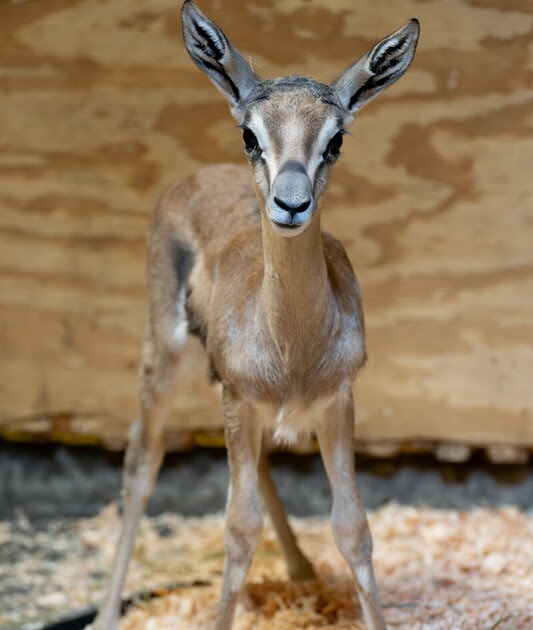Summary of Introducing Dawa! This little gazelle calf provides a big dose of joy!:
Elizabeth Bacher, part of the Communications team, shares an announcement about Dawa, a newly born Grant’s gazelle at the Woodland Park Zoo, the first since 2005. Born on March 5 to parents Blossom and Kamali, the calf was named Dawa—a Swahili word meaning “medicine” or “cure”—inspired by the music of The Cure playing during her birth. Weighing around 6 pounds at birth and now at 7 weeks old, Dawa has grown to approximately 25 pounds. Although not yet visible to the public as she stays behind the scenes with her mother, Dawa has been busy mastering the art of pronking, a characteristic bouncing gait, and sampling solid foods alongside her mother’s milk. The zoo maintains a close watch on the health of its gazelle herd, employing a combination of treating feeding stations and scales to monitor their weight without causing stress. Dawa’s eventual weaning will mark her transition to a diet of timothy hay, beet pulp, carrots, apples, romaine, and specialized grain-based pellets. The zoo promises to introduce Dawa to the public once she is ready to join the savanna exhibit, alongside information-filled videos and pictures highlighting her growth and development stages.
– Understanding the significance of introducing new animals to zoo habitats and conservation programs
– The biological and behavioral traits of Grant’s gazelles and the role of infant gazelles in their ecosystems
– The importance of enrichment and the well-being of zoo animals, with a focus on innovative zoo management practices
– Challenges and solutions in wildlife conservation, highlighting the balance between captivity and natural habitats
The introduction of Dawa, a newborn Grant’s gazelle, at Woodland Park Zoo marks a significant occasion for the zoo and the broader efforts in conserving Grant’s gazelles. This event offers a unique opportunity to explore the intricate balance between animal care in captivity and the overarching goals of wildlife conservation.
Grant’s gazelles are a species that thrive in the savannas and grasslands of Eastern Africa. They are known for their incredible agility and speed, reaching up to 90 km/h, making them one of the fastest animals. Gazelles such as Dawa possess a unique adaptation known as ‘pronking’ or ‘stotting,’ where they jump into the air with all four feet to demonstrate their vigor and potentially evade predators. This behavior is not just a physical exercise; it’s a critical survival tactic in the wild, showcasing the animal’s fitness and alertness.
In zoo environments, animal introductions, especially those as joyous as the birth of Dawa, present an opportunity to engage the public in understanding the delicate nuances of animal behavior and conservation. The behind-the-scenes care that Dawa and her family receive at Woodland Park Zoo is a testament to the zoo’s commitment to animal welfare. This involves a diet that mimics the nutritional values they would find in the wild, spaces designed to encourage natural behaviors like pronking, and careful monitoring to ensure their health and growth.
Zoos’ role beyond being a venue for public entertainment is exemplified in efforts to conserve species and educate the public about the challenges faced by animals like Grant’s gazelles in the wild. Habitat loss, poaching, and climate change have made conservation work increasingly vital. Captive breeding programs and research are essential in preserving species, offering hope for future reintroductions into protected areas.
Moreover, including enrichment practices is critical in maintaining animals’ physiological and psychological health in captivity. For gazelles, this may involve exploring varied terrain, puzzle feeders that stimulate their problem-solving skills, and opportunities to engage in natural behaviors such as browsing. These practices not only enhance the quality of life for the animals but also provide zoo visitors with a more accurate representation of natural behaviors and interactions.
The story of Dawa’s introduction to the zoo and her growth milestones offers a narrative thread that weaves together themes of animal care, conservation, and public education. This journey underscores wildlife conservationists’ challenges in simulating natural habitats within zoos and the importance of global conservation efforts. By supporting healthy animal populations in captivity, zoos contribute to the genetic diversity necessary for the species’ long-term survival.
Furthermore, it highlights the importance of research in understanding species-specific needs and behaviors. By studying animals like Dawa and her family, zoologists gain insights into reproductive biology, social structures, and dietary needs, which can inform captive animal care and conservation strategies in the wild.
In summary, the arrival of Dawa at Woodland Park Zoo represents more than a new addition to the zoo’s family. It serves as an educational corner for visitors to learn about the fascinating biology of Grant’s gazelles, the intricacies of animal care, and the critical role zoos play in conservation. Through carefully managing captive populations and public engagement, zoos worldwide contribute to preserving species and habitats, underlining the interconnectedness of all living beings and the importance of concerted conservation efforts.

